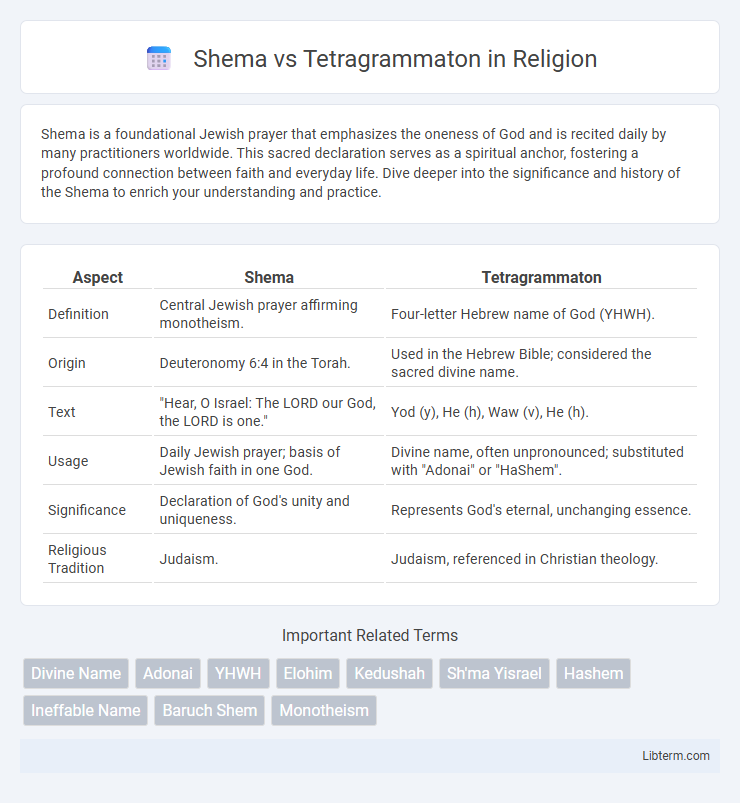Shema is a foundational Jewish prayer that emphasizes the oneness of God and is recited daily by many practitioners worldwide. This sacred declaration serves as a spiritual anchor, fostering a profound connection between faith and everyday life. Dive deeper into the significance and history of the Shema to enrich your understanding and practice.
Table of Comparison
| Aspect | Shema | Tetragrammaton |
|---|---|---|
| Definition | Central Jewish prayer affirming monotheism. | Four-letter Hebrew name of God (YHWH). |
| Origin | Deuteronomy 6:4 in the Torah. | Used in the Hebrew Bible; considered the sacred divine name. |
| Text | "Hear, O Israel: The LORD our God, the LORD is one." | Yod (y), He (h), Waw (v), He (h). |
| Usage | Daily Jewish prayer; basis of Jewish faith in one God. | Divine name, often unpronounced; substituted with "Adonai" or "HaShem". |
| Significance | Declaration of God's unity and uniqueness. | Represents God's eternal, unchanging essence. |
| Religious Tradition | Judaism. | Judaism, referenced in Christian theology. |
Introduction to Shema and Tetragrammaton
The Shema, a central declaration of Jewish faith found in Deuteronomy 6:4, emphasizes the oneness of God with the phrase "Hear, O Israel: The LORD our God, the LORD is one." The Tetragrammaton, represented by the four Hebrew letters YHWH, is the sacred and ineffable name of God, signifying divine eternity and unchanging nature. Both the Shema and the Tetragrammaton hold profound theological significance, highlighting monotheism and God's unique identity in the Hebrew Bible.
Origins and Historical Context
The Shema, a central declaration of Jewish monotheism found in Deuteronomy 6:4, historically emphasizes the unity and singularity of God, rooted in Israelite tradition during the early biblical period. The Tetragrammaton, represented by the four Hebrew letters YHWH, originated as the sacred and ineffable name of God revealed to Moses in Exodus 3, reflecting a divine self-identification with eternal existence. Both entities emerged in distinct but overlapping historical contexts within ancient Israel, where the Shema articulated faith in one God, while the Tetragrammaton expressed God's personal and covenantal identity.
Linguistic Meaning and Etymology
The Shema, a central declaration in Jewish prayer, derives from the Hebrew verb "SHm`" (shama), meaning "to hear" or "to listen," emphasizing attentiveness to God's unity. The Tetragrammaton, represented by the four Hebrew letters yhvh (YHWH), originates from the root "hyh" (h-y-h), meaning "to be," highlighting God's eternal and self-existent nature. Linguistically, the Shema commands receptive faith while the Tetragrammaton encapsulates divine identity through etymology.
Theological Significance
The Shema, centered on Deuteronomy 6:4, emphasizes the unity and singularity of God, underscoring monotheism foundational to Jewish theology. The Tetragrammaton (YHWH) represents the specific, ineffable name of God, revealing His eternal, self-existent nature and covenantal relationship with Israel. Together, the Shema and Tetragrammaton highlight God's transcendence and immanence, shaping Hebrew worship and theological identity.
Usage in Jewish Worship
The Shema, a central declaration of monotheistic faith, is recited daily in Jewish worship to affirm the oneness of God, while the Tetragrammaton (YHWH) represents the divine personal name traditionally considered too sacred for direct pronunciation. The Shema incorporates the concept of God's unity, often substituting the Tetragrammaton with titles like Adonai during prayer to maintain reverence. This practice underscores the theological emphasis on God's indivisibility and the sanctity of God's name in liturgical contexts.
Role in Daily Jewish Life
The Shema serves as a central declaration of faith in daily Jewish prayer, affirming the oneness of God and guiding ethical conduct. The Tetragrammaton, representing the ineffable name of God (YHWH), is treated with reverence and often substituted with Adonai or Hashem during prayers to maintain holiness. Together, these elements shape Jewish spiritual practice, emphasizing devotion, identity, and the sacred presence in everyday life.
Differences in Scriptural References
The Shema, found in Deuteronomy 6:4, emphasizes the singularity of God with the phrase "Hear, O Israel: The LORD our God, the LORD is one," using the Tetragrammaton YHWH to denote the divine name. In contrast, the Tetragrammaton itself, appearing over 6,800 times in the Hebrew Bible, serves as the specific personal name of God, representing His eternal and covenantal nature. While the Shema is a declaration of monotheistic faith, the Tetragrammaton functions as the distinct scriptural identifier of God across various texts like Genesis, Exodus, and Psalms.
Mystical and Kabbalistic Perspectives
The Shema, central to Jewish prayer, emphasizes the unity of God as "Hear, O Israel: the Lord our God, the Lord is one," reflecting an essential monotheistic belief. Kabbalistic teachings interpret the Tetragrammaton (YHWH) as a complex representation of divine emanations through the four sefirot--Chesed, Gevurah, Tiferet, and Malchut--symbolizing God's interaction with the universe. Mystically, the Shema is seen as a declaration of oneness, while the Tetragrammaton embodies the dynamic, multifaceted nature of God's presence and creative force in existence.
Modern Interpretations and Relevance
Modern interpretations of the Shema emphasize its role as a foundational declaration of monotheism and spiritual identity in Judaism, highlighting its call to love and devotion to one God. The Tetragrammaton, represented by the four Hebrew letters YHWH, is studied as the ineffable name of God, inspiring theological reflection on divine presence and holiness in contemporary Jewish practice. Both the Shema and Tetragrammaton retain profound relevance in modern religious discourse, symbolizing a continuous connection to ancient faith and the evolving understanding of God's nature.
Conclusion: Shema vs Tetragrammaton
The Shema encapsulates the core declaration of monotheistic faith, emphasizing the oneness of God, while the Tetragrammaton represents the specific, ineffable name of God revealed in the Hebrew Bible. Both hold profound theological significance, with the Shema focusing on the unity and singularity of God, and the Tetragrammaton highlighting the divine identity and covenantal presence. Understanding their distinct functions enriches the comprehension of Jewish spirituality and scriptural tradition.
Shema Infographic

 libterm.com
libterm.com